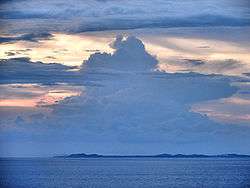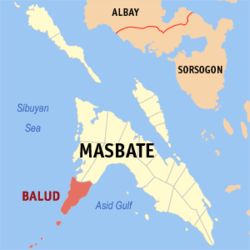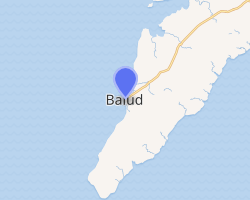Balud
Balud, officially the Municipality of Balud, is a 4th class municipality in the province of Masbate, Philippines. According to the 2015 census, it has a population of 38,124 people.[3]
Balud | |
|---|---|
| Municipality of Balud | |
 Silhouette of Jintotolo Island | |
 Seal | |
 Map of Masbate with Balud highlighted | |
OpenStreetMap 
| |
.svg.png) Balud Location within the Philippines | |
| Coordinates: 12°02′13″N 123°11′37″E | |
| Country | |
| Region | Bicol Region (Region V) |
| Province | Masbate |
| District | 2nd district |
| Barangays | 32 (see Barangays) |
| Government | |
| • Type | Sangguniang Bayan |
| • Mayor | Ruben Jude D. Lim |
| • Vice Mayor | Felimon C. Abelita III |
| • Congressman | Elisa T. Kho |
| • Electorate | 26,518 voters (2019) |
| Area | |
| • Total | 231.00 km2 (89.19 sq mi) |
| Population (2015 census)[3] | |
| • Total | 38,124 |
| • Density | 170/km2 (430/sq mi) |
| • Households | 7,843 |
| Economy | |
| • Income class | 4th municipal income class |
| • Poverty incidence | 42.27% (2015)[4] |
| • Revenue (₱) | 103,450,468.71 (2016) |
| Time zone | UTC+8 (PST) |
| ZIP code | 5412 |
| PSGC | |
| IDD : area code | +63 (0)56 |
| Climate type | tropical rainforest climate |
| Native languages | Masbateño language Hiligaynon Capiznon Tagalog |
The name Balud came from the name of a bird.
Barangays
Balud is politically subdivided into 32 barangays. [2]
- Baybay (Lumocab)
- Bongcanaway
- Mabuhay (Bongcanaway III)
- Calumpang
- Cantil
- Casamongan
- Dao
- Danao
- Guinbanwahan
- Ilaya
- Jangan
- Jintotolo
- Mapili
- Mapitogo
- Pajo
- Palani
- Panguiranan
- Panubigan
- Poblacion (Balud)
- Pulanduta
- Quinayangan Diotay
- Quinayangan Tonga
- Salvacion
- Sampad
- San Andres (Quinayangan Dacu)
- San Antonio
- Sapatos
- Talisay
- Tonga
- Ubo
- Victory
- Villa Alvarez
Panguiranan is a village/barangay located on the east side of the Municipality of Balud. With the growing population and a thriving fishing area within the Asid Gulf, Panguiranan is a hub for small fisherman in selling their day's catch.
Climate
| Climate data for Balud, Masbate | |||||||||||||
|---|---|---|---|---|---|---|---|---|---|---|---|---|---|
| Month | Jan | Feb | Mar | Apr | May | Jun | Jul | Aug | Sep | Oct | Nov | Dec | Year |
| Average high °C (°F) | 29 (84) |
29 (84) |
31 (88) |
32 (90) |
32 (90) |
31 (88) |
30 (86) |
30 (86) |
30 (86) |
30 (86) |
29 (84) |
29 (84) |
30 (86) |
| Average low °C (°F) | 23 (73) |
22 (72) |
23 (73) |
23 (73) |
25 (77) |
25 (77) |
24 (75) |
25 (77) |
24 (75) |
24 (75) |
24 (75) |
23 (73) |
24 (75) |
| Average precipitation mm (inches) | 39 (1.5) |
34 (1.3) |
42 (1.7) |
36 (1.4) |
73 (2.9) |
109 (4.3) |
118 (4.6) |
108 (4.3) |
129 (5.1) |
136 (5.4) |
112 (4.4) |
89 (3.5) |
1,025 (40.4) |
| Average rainy days | 12.6 | 9.7 | 12.0 | 13.0 | 20.5 | 25.3 | 26.2 | 24.8 | 25.2 | 25.9 | 21.9 | 17.9 | 235 |
| Source: Meteoblue [5] | |||||||||||||
Demographics
|
| ||||||||||||||||||||||||||||||||||||
| Source: Philippine Statistics Authority[3][6][7][8] | |||||||||||||||||||||||||||||||||||||
In the 2015 census, the population of Balud, Masbate, was 38,124 people,[3] with a density of 170 inhabitants per square kilometre or 440 inhabitants per square mile.
gollark: Yes, because they needed to add a bunch of code to *it* to handle that.
gollark: > journalctl is not greatWell, I can conveniently check "hmm yes what has this service outputted in the last few minutes", follow logs, and specify stuff like "dnscrypt-proxy should only start when the network goes up".
gollark: I don't think UK curricula cover them until A level.
gollark: Or... actually in most countries that I know of.
gollark: Not here!
References
- "Municipality". Quezon City, Philippines: Department of the Interior and Local Government. Retrieved 31 May 2013.
- "Province: Masbate". PSGC Interactive. Quezon City, Philippines: Philippine Statistics Authority. Retrieved 12 November 2016.
- Census of Population (2015). "Region V (Bicol Region)". Total Population by Province, City, Municipality and Barangay. PSA. Retrieved 20 June 2016.
- "PSA releases the 2015 Municipal and City Level Poverty Estimates". Quezon City, Philippines. Retrieved 1 January 2020.
- "Balud: Average Temperatures and Rainfall". Meteoblue. Retrieved 23 June 2020.
- Census of Population and Housing (2010). "Region V (Bicol Region)". Total Population by Province, City, Municipality and Barangay. NSO. Retrieved 29 June 2016.
- Censuses of Population (1903–2007). "Region V (Bicol Region)". Table 1. Population Enumerated in Various Censuses by Province/Highly Urbanized City: 1903 to 2007. NSO.
- "Province of Masbate". Municipality Population Data. Local Water Utilities Administration Research Division. Retrieved 17 December 2016.
External links
- Balud Profile at PhilAtlas.com
- Philippine Standard Geographic Code
- 2000 Philippine Census Information
- Local Governance Performance Management System
This article is issued from Wikipedia. The text is licensed under Creative Commons - Attribution - Sharealike. Additional terms may apply for the media files.